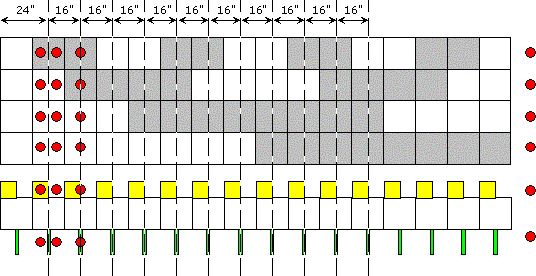Ron,
I was responding to Post #15. In Post #15, Timbo said...
I must stop my cylinders in many different spots is because I will have multiple straps spaced evenly accrossed my package. i.e.(move 18" then strap, move 18" then strap) I could only find one reasonable source for 8 foot long cylinders, and I have build a compound extension to get 16 feet of travel from my 8 foot cylinder. One must have 5 stopping positions plus full retract and full extend. The other must have 6 stopping positions plus full retract and full extend.
He called for 11 stop/strap positions spaced 18" apart - with some kind of sensor indication for each stop. Then he called for four additional sensors to indicate extended/retracted on each of two 8-foot cylinders.
I really don't think I'm too far off the mark.
Eric said,
What's nice is that you have a total of 7 positions, so 3 prox. switches is all you need.
Eric, I'm pretty sure... wait, let me check again... ... ... yep! I'm really sure that Timbo said he wanted to have 11 stop/strap positions in addition to Full Extended and Full Retracted indications for each cylinder. That sounds like 15 positions - some of those could be combined to reduce the position count a bit - not much.
Your plan can be applied twice - once for each cylinder - a total of 6 sensors. That will give Timbo the positions he asked for.
Eric also said...
Instead of trying to keep track of the cylinder's position by counting, it might be better to let the prox. switches give absolute position feedback.
A Prox watching for a flag can only tell you when the flag and prox are in close proximity. While between flags the system has no idea where it really is! There's no "absolute" position information in that! That method requires a certain amount of faith that things will operate as they should.
Let's see... I was at Prox-5 and I'm extending... so, I must be between Prox-5 and Prox-6 and heading toward Prox-6... maybe. I sure hope Prox-6 is there! That is not an "absolute" indication. That really seems more "faith-based" than "absolute"... don't ya think?
The first flag that I showed was "bait". It is actually one of two flags - and the second flag is actually two flags combined. The "Gray Code" flag (the first one) was for identifying the "segment". The grayed squares "were" all black. As such, the flag lost some of its detail. I used gray blocks with black lines so as to clearly identify the "block-segments" in the flag.
The second flag is used for "dialing in" the strap position.
The first move on the far left might not be 24" - probably not.
Actually, the whole flag arrangement can be slid from one side to the other as necessary to "capture" the retracted and extended conditions.
The first flag can only identify a particular 18-inch segment (or is it a 16-inch segment? Timbo???). The prox's certainly can detect the transition-edge... but... while the prox is OFF, where is the strapper-head? And while the prox is ON, where is the strapper-head?
The second flag consists of two minor flag-types: "low/high" in a segment (yellow = low) and "dead-on" (green). While the prox sees the yellow flag and not the green flag, the system knows that it is in the lower section of the segment. As soon as the prox sees the green flag the system ignores the yellow flag and stops the cylinder. The system knows that the strapping-head is at the strapping position for Segment-X (identified by the Gray Code flag). If the strap-head happens to drift away from the strap position the yellow flag will indicate the direction of drift. Ya never know... that might be a handy piece of info to know!
This scheme works more like an "absolute" encoder. It allows the cylinders to be extended (or retracted if Timbo decides to use two-way processing) at controlled speeds. The strapper-head can leave a segment quickly, then when it sees the yellow flag, the cylinder can
slow-down until the green flag is seen - then it stops, straps, and then moves on quickly to the next location.
This scheme uses 6 prox's. The "absolute" positions, relative to flag-edges, are known in this scheme as well as they are known in your scheme. However, this scheme also provides a broader sense of the "absolute" position plus a solid "relative" position - all without timers or counters.
The bottom line is, this system
knows where the strapper-head is relative to any given strap position at any time - even on start-up!
So then, just to make my head feel like Goody's avatar looks, Timbo says this in Post #20...
My movement is spaced fairly evenly at 16" roughly in each move. Could I get away with four proxs on each ram? One for full extend, one for full retract to protect pump, valve, and hoses. Then the other two spaced at 16" with a sliding rod with flags. Move to prox 1 stop strap, move to prox 2 stop strap, move to prox 1 stop strap and so on.
Timbo... Didn't you say (in Post #15) that you want to have 11 strapping positions, and that you already had, and was therefore committed to using, 8-foot cylinders???
Of course, by this time, Timbo has probably already started a new thread with a nice little picture... oh, well...
I'm tired of editing... have at me!






